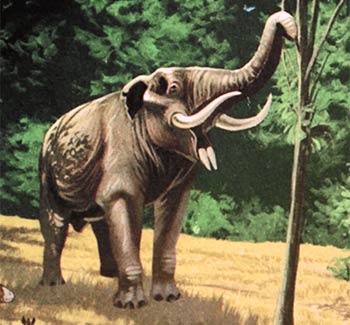Last updated: April 15, 2020
Lesson Plan
Which Bone Goes Where

- Grade Level:
- Upper Elementary: Third Grade through Fifth Grade
- Subject:
- Science
- Lesson Duration:
- 30 Minutes
- Additional Standards:
- 3rd Grade: 3-LS4-1, 3-LS4-2, and 3-LS4-3
4th Grade: 4-LS1 and 4-LS1-1
5th Grade: 5-LS2, LS2.A, and LS2.B
6th Grade: MS-LS1-4, LS1.B, MS-LS2, MS-LS2-1, and LS2.A - Thinking Skills:
- Applying: Apply an abstract idea in a concrete situation to solve a problem or relate it to a prior experience. Analyzing: Break down a concept or idea into parts and show the relationships among the parts. Creating: Bring together parts (elements, compounds) of knowledge to form a whole and build relationships for NEW situations.
Essential Question
How do present-day animals help paleontologist understand the anatomy of fossil animals?
Objective
Construct a Mastodon skeleton by reviewing the illustration of a present-day elephant.
Background
Teachers should read and review information in Biodiversity and Adaptation with students.
Preparation
Materials:
Elephant illustration (for reference)
Extinct Mastodon pieces (to print)
Extinct Mastodon whole illustration (for reference)
Scissors
Construction paper
Glue
Procedure
Step One: Explain the following to students. Vertebrate paleontologists learn how to put fossils together by looking at how bones are arranged in modern animals. When paleontologists find fossils out in the field, they are not always preserved in a perfect skeletal arrangement. Sometimes bones have been scattered and even sometimes bones are missing! Paleontologist must use the skeletons of modern animals to put back together the skeletons of fossil animals. Today you will be using the skeleton below of a modern elephant to put back together the skeleton of an extinct Mastodon.
Step Two: Print out Extinct Mastodon pieces diagram for each student. Students will also need scissors, glue, and a piece of construction paper.
Step Three: Students will cut out the Mastodon skeletal pieces then use the Elephant skeletal diagram to put the Mastodon skeleton back together. When their skeleton is correctly arranged, they will glue the pieces down on construction paper.
Step Four: Discussion with students if it was difficult to put the Mastodon skeleton back together. Ask student if they think it would have been harder to put together the Mastodon skeleton if they didn’t have the elephant skeleton for reference.
Step Five: Complete Survival of the Fittest Lesson Plan.
Step Six: Complete Physical or Behavioral Adaptation Lesson Plan.
Step Seven: Complete the Post-Unit Questions found on Biodiversity and Adaptation.
Vocabulary
Abiotic factors: non-living components of an environment such as climate, soil, and water.
Adaptations: any physical or behavioral characteristics of an organism that help it to survive in its environment.
Behavioral adaptation: something an animal does usually in response to some type of external stimulus in order to survive. Hibernating during winter is an example of a behavioral adaptation.
Biodiversity: measure of the variety of life on Earth, including habitat diversity, and the interconnectedness that ties life and habit together.
Biotic factors: living components of an environment such as plants and animals.
Environment: all the influences, both biotic and abiotic in nature, which affect an organism.
Paleoecology: the study of ecosystems of the past through the fossil record.
Physical adaptation: type of structural modification made to a part of the body.
Contact Information
Email us about this lesson plan
